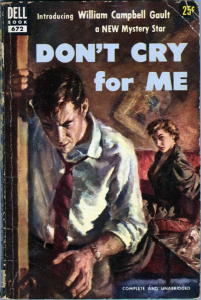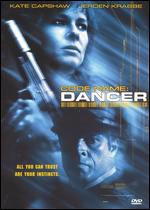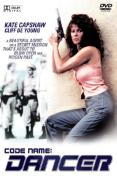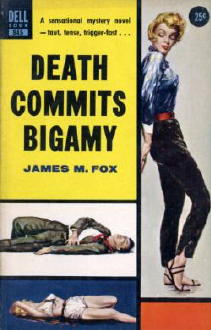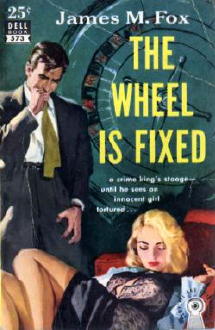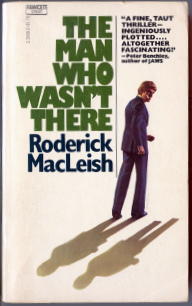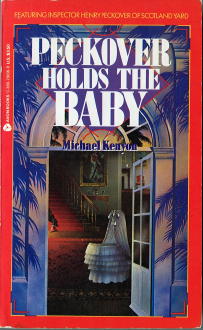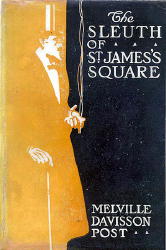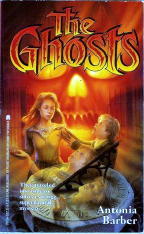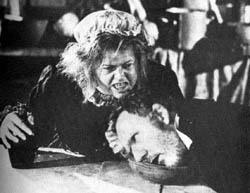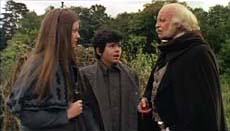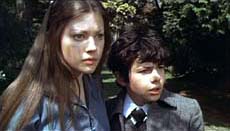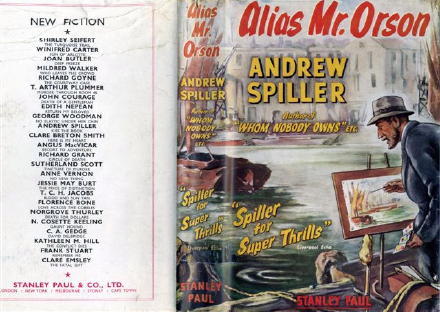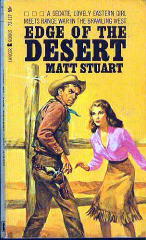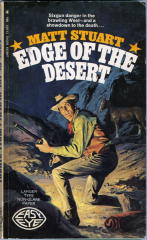May 2007
Monthly Archive
Thu 24 May 2007
Posted by Steve under
Authors ,
ReviewsNo Comments
Going on right now at the The Rap Sheet is an ongoing celebration of the blog’s first year online. The party consists not of frivolities, but the serious matter of books forgotten that should not be. At least a hundred contributors are offering their selection of ONE book each that they’d like to recommend to save from oblivion.
As you can imagine, the selections run the gamut from old to new, cozies, hard-boiled, spy novels, the works. If you can’t find something to catch your eye among the list of books selected, you’re reading the wrong blog, that’s all I can say. It’s a spectacular display of mystery wisdom and knowledge, there’s no doubt about it, delivered with grace and panache.
Here’s my contribution. A longer review will show up here also, eventually. (I’m running behind, as usual.)
ONE crime/mystery/thriller novel that I think has been most unjustly overlooked, criminally forgotten, or underappreciated over the years?
I started to think about this and my brain froze. Overload. But how about this one? Well, any of WILLIAM CAMPBELL GAULT’s early books will do, those he wrote between 1952 and 1963. His second career began again in 1980, and I confess that I haven’t gotten to any of those yet, but I will.
Pick one. How about his first one then? DON’T CRY FOR ME is the title, and it’s one of his non-series, non-PI books. The leading character is Pete Worden, ex-football star and the scourge of his family, cut off by his brother from his inheritance for his low-life, lack-luster attitude and approach to living.
Invited to a crime boss’s party, he wins a bundle of cash at a dice game and ends up knocking out one of the losers. He later finds the guy waiting for him in his apartment, dead, with a knife in his throat.
Gault’s usual complaints about the differences between the moneyed class and the rest of California society are in full force in this book, in his usual light but curmudgeonly way. But it’s not only the clash between classes that concern him. It’s also the fracture that exists between the educated and not, literature vs. pulp fiction, and wedges that occur even in families and pitting brother against brother — prime examples being Pete and his straight-and-narrow brother John, paired off and contrasted with the crime boss’s two youthful sons, with the surgical precision of a natural-born writer highlighting the differences between them.
Cynical and sour in general motif, maybe, but it’s also one heck of a detective story. It won the Edgar for the Best First Mystery Novel in 1953.
Thu 24 May 2007
CODE NAME: DANCER. [a/k/a HER SECRET LIFE] Made-for-TV; Phoenix Entertainment, 1987. Kate Capshaw, Jeroen Krabbé, Gregory Sierra, Cliff De Young, Valerie Mahaffey. Directed by Buzz Kulik.
You’ll have to be careful when you start hunting down a copy of this one. If it’s part of a double feature DVD, as the first one I happened to have watched was, there’s about four minutes missing just before the end. It sort of made sense, but not enough, and I had to find another DVD on eBay with just the one movie on it in order to have a sense of completion. If you know what I mean.
Of course, you can live happily ever after if you never see this movie at all, and perhaps I should tell you something about it. Annie Goodwin (that’s Kate Capshaw), happily married – with pains taken to show her blissful suburban California life – gets a call from her former employer, the CIA, or someone who knows she worked for the CIA – that calls in a favor for a former colleague/superior who’s in trouble back in their old stomping grounds, Cuba.
That’s the Dancer (Gregory Sierra). Faking an injury to her sister to explain her absence at home, Annie is back in business again, which involves a former lover, Malarin (Jeroen Krabbé), a man close to Castro – and man, I’m telling you the whole story. You can probably make one up as good as this one without trying too hard, or perhaps you might want to add something to this one, which is truthfully a little thin for its 94 minutes running time.
Lots of flashbacks transpire, however – I think I can tell you that – and things don’t end all that well for everyone. It’s all very serious and dramatic with only a small amount of humor involved, and what there is centers around the plight of the hapless husband Paul (Cliff De Young) who’s left behind. The ending, in fact, is left open for a possible series to result from this, but it never happened.
For Kate Capshaw, by the way, this movie was post- Indiana Jones and pre- Mrs. Steven Speilberg and was, all things considered, I’m sure, only a minor milestone in her career.
And in case you were wondering, the first DVD cost me maybe a dime (bag day at the local library sale) and the second one only a dollar. For a dollar, it’s a keeper.
Tue 22 May 2007
JAMES M. FOX – The Wheel Is Fixed
Dell 573; paperback reprint; no date stated, but circa 1951; mapback edition. Hardcover edition: Little, Brown; 1951. Also: Raven House #33, pb, 1980; 2nd printing (#22), pb, 1982.
I may have the Raven House numbering scheme all wrong. The first printings you got only by subscribing to their overall line of books, which is what I did at the time. I never paid their mass market distribution (the later printings) much attention — who cared? — and they WERE different. There was a noticeable discrepancy in which books were published in one versus the other, for example, and a different numbering on those that were. To get information on the later printings now, all I’m able to do is look online to see how sellers describe their books for sale, which I have to admit, even between you and me, is a pretty pitiful way to conduct honest-to-goodness research.
[UPDATE: It belatedly has occurred to me that Michael L. Cook included a complete checklist of the subscription Raven’s (through #72) in his book on book clubs, Murder by Mail (Bowling Green University Popular Press, revised edition, 1983). I can therefore confirm that The Wheel Is Fixed was indeed #33. What the numbers were in the list of later printings, however, Mr. Cook does not say.]
The other books by Fox that were reprinted in the Raven House line are:
#45. A Shroud for Mr. Bundy. [A John and Suzy Marshall mystery published in hardcover by Little Brown in 1952 and reprinted by Jonathan Press as a digest-sized paperback.]
#61. The Coven. [A paperback original; 1981.]
Fox, whose real name was Johannes Matthijs Willem Knipscheer (1908-1989), had a mystery-writing career that began in 1943 with the first John and Suzy Marshall book, and ended in 1989 with a mystery western from PaperJacks entitled Crunch.
Not that I know very much about the Marshalls, but since Fox’s career began with one of their adventures – and in fact The Wheel Is Fixed is the first one which is not – and it’s their books that Fox may be remembered most for, if at all, I’ll go ahead and provide you with a complete checklist of them, taken from Crime Fiction IV, by Allen J. Hubin:
Don’t Try Anything Funny. Davies, UK, 1943.
Hell on the Way. Davies, UK, 1943.
Journey Into Danger. Cherry Tree UK, pb, 1943.
Cheese from a Mousetrap. Davies, UK, 1944.
The Lady Regrets. Coward-McCann, 1947. Dell 338, pb, 1949.
Death Commits Bigamy. Coward-McCann, 1948. Graphic 14, pb, 1949. Dell 845, pb, 1955.
The Inconvenient Bride. Coward-McCann, 1948. Dell 463, pb, 1950.
The Gentle Hangman. Little Brown, 1950. Dell 526, pb, 1951.
The Aleutian Blue Mink. Little Brown, 1951. Dell 623, pb, 1952, as Fatal in Furs.
The Iron Virgin. Little Brown, 1951. Dell 719, pb, 1953.
The Scarlet Slippers. Little Brown, 1952. Dell 685, pb, 1953.
A Shroud for Mr. Bundy. Little Brown, 1952. Jonathan Press J92, digest-sized pb, March 1957.
Bright Serpent. Little Brown, 1953. Jonathan Press J96, digest-sized pb, probably early 1958, as Rites for a Killer.
Plus one short story:
“Start from Scratch.” Four-and-Twenty Bloodhounds, Anthony Boucher, editor, Simon & Schuster, 1950.
Most of the stories took place in Los Angeles, CA. Why the first ones were published in the UK, I do not know, nor why they were never published here. (I do have a copy of Cheese from a Mousetrap. Perhaps I need to read it.)
On his Thrilling Detective website, Kevin Burton Smith refers to the Marshalls as “Nick and Nora wanna-be’s.” Since once again I’ve not read one that I remember reading, I’m going have to fall back on quoting Kevin and leave it at that, for now: “Where Nick and Nora were rather urbane and urban sophisticates, constantly traveling from one trouble spot to another, martinis in hand, Johnny and Suzy were suburban all the way, beer-drinkers and homebodies, who didn’t have to go far, it seemed, to find trouble. It always seemed to find them, thanks to Johnny’s job as a private detective.”
By 1953, the market demand for the Marshalls seems to have disappeared. All of the books written by Fox wrote after then seem to be action- and adventure-oriented, although I am allowing myself to say that only on the basis of seeing the names of the titles, in which stock you should know how much to put. [FOOTNOTE]
The Wheel Is Fixed appeared before at least the last three Marshalls, and it starts out as if it’s going to be one of the best unknown noirs ever written. A former orchestra leader named Rick Bailey and a girl named Lorna, described in a newspaper as a motion picture actress, are holed up in El Paso as fugitives from justice. Hunt Couple in Palm Springs Swim Pool Massacre, reads the headline of that very same newspaper. “They found the car in Phoenix yesterday,” Rick tells us, the reader, “which proves that we crossed a State line and makes us eligible for five years in the Federal penitentiary right there.”
Lorna’s hands are bandaged, making it difficult for the couple to escape notice, and they see strange men on their trail everywhere they go. Checking into the Cortex Hotel, they hope against hope they will be able to cross the Rio Grande on the following day.
At which point [end of Chapter One] Rick decides to put down the entire story down on paper, so that “at least the truth will be known, and the deal will have to from the top of the deck.”
It’s flashback time, in other words, and unfortunately the next part of the story is not nearly as gripping as either the beginning. As for the ending, that comes later, which of course you knew before I told you, and I’ll get to it shortly. But what happens next, or first, if you are still with me, is that Bailey, down on his luck, is hired by a well-heeled gangster (and a heel to boot) to get a woman out of his son’s hair. A semi-interesting sojourn to Palm Springs develops from there, and several false starts later – or so they seem at the time – we finally, 150 pages later, get to the crux of the matter, and hence the headline.
Thirty more pages from there, we have caught up with the present, and Rick Bailey has run out of things to put down on paper. The last remaining twelve pages are worthy of the opening chapter, let me tell you, in case I’d left you wondering, complete with at least one sock-removing twist I didn’t see coming, maybe even both sox, lulled perhaps to unawareness by the soporific middle stanza, or at least that’s the way I’m telling it.
It is uneven, the story is, but in 1951 they built mystery and detective fiction of every subgenre and variety on puzzles and twists, and as I say,so it is here in the end. This particular effort on the part of Mr. Fox has not fared well over time, in terms of general recognition then and hardly now. All in all, this is mostly a forgotten book by an all but forgotten writer, but I’ll remember it for its good (if not great) parts at either end, and noticeably less for its lack of pace and cohesiveness in the middle.
[FOOTNOTE] When I first wrote the review, which as you can see was nearly a year ago, I was somewhat less inclined toward completeness in providing checklists than I am now. Here is it the next day on the blog, and here are the rest of Fox’s mystery titles. I said they were action- and adventure-oriented. Feel free to judge for yourself. [US first editions only, unless indicated; settings and series characters, if any, are included.]
# The Wheel Is Fixed (n.) Little 1951 [California]
# Code Three (n.) Little 1953 [Sgt. Jerry Long; Sgt. Chuck Conley; Los Angeles, CA]
# Dark Crusade (n.) Little 1954 [Steve Harvester; Paris]
# Free Ride (n.) Popular Library 1957 [Sgt. Jerry Long; Sgt. Chuck Conley; Train; U.S. South]
# Save Them for Violence (n.) Monarch 1959 [Mexico]
# Dead Pigeon (n.) Hammond, UK, 1967. US title:
Dead Canary, Manor, pb, 1979. [Sgt. Jerry Long; Sgt. Chuck Conley]
# Operation Dancing Dog (n.) Walker 1974 [Steve Harvester]
# The Coven (n.) Raven 1981 [California]
# Crunch (n.) PaperJacks 1988 [U.S. West]
Tue 22 May 2007
Posted by Steve under
Authors ,
CoversNo Comments
I was cleaning out the far end of my Toyota minivan yesterday, and I came across a box of books that had been there since last December, which coincidentally enough was the last time I went out bookhunting. My friend Paul and I had gone up to the Northampton MA area for the day, and when we came home I thought better of lugging the books into the garage, which I was in the process of cleaning out, or trying to, and decided just to leave them in the back of the car.
Which they were happy to be, until yesterday. And I was quite pleased to sort through my purchases again, marveling at what presence of mind I had to pick up so many books that I needed and still wanted.
And two of them were more relevant than others. In my recent post on Roderick MacLeish, for example, I tried to explain the plot line for The Man who Wasn’t There, but without the book in hand, I didn’t know what I was trying to convey, and so how possibly could you?
I have a copy of the paperback edition now, and thanks to the person who wrote the blurb on the back cover, it makes a lot more sense now:
“Aren’t you Rex Carnaby, the movie star?” asked the stranger on the plane. His name was Follensby.
“No,” said Rex.
“Jesus, you sure look like him!”
“I’m his brother, Frederick Jackson Carnaby. We’re twins!”
— This was the kind of lie with which millionaire film star Rex Carnaby often rid himself of autograph seekers. But this time it had very different results. The next day in Washington, Rex was shocked to read that the man he had invented was dead!
This is more like it. A book to be put immediately on the To Be Read pile.
The other book, one by Michael Kenyon, whose passing was also noted here not too long ago, was an Avon paperback reprint of Peckover Minds the Baby. The plot line was described before in a couple of short lines, so I won’t repeat it, even at longer length.
But I like the cover, the artwork uncredited as usual, even in 1988, and here it is. (The details are very fine, and I hope you can make them out. That’s a portion of the arm of a body that you see toward the bottom of the stairs, for example.)
And yes, you’re right, another book To Be Read, as soon as I can get to it.
Mon 21 May 2007
Melville Davisson Post was born in 1869 and died in 1930, and is considered by some to be
America’s Greatest Mystery Writer. He is best known for his primary series character, Virginia backwoodsman Uncle Abner, who with great religious and moral rectitude solved crimes during the presidency of Thomas Jefferson.
Lesser known are two other characters, Randolph Mason, a lawyer in the 1890s who advises his clients on how to commit crimes and avoid punishment; and the detective of note in the book reviewed below, Sir Henry Marquis. “In the far corners of the earth and in the most intimately known places the reader travels. In delightful suspense he follows the destinies of singers, hoboes, mock priests, beautiful creoles, sinister hunchbacks, and German officers to their inevitable climax.”
And with that brief introduction, Mary Reed will take it from here.
MELVILLE DAVISSON POST – The Sleuth of St. James’s Square
D. Appleton & Co., New York & London, hardcover, 1920.
The sleuth who lives in a large house in St. James’s Square, London, is Sir Henry Marquis, head of the Criminal Investigation Department of Scotland Yard. He also owns a country mansion and a villa on the French Riviera and internal evidence suggests he was educated at Rugby’s famous public school and Oxford University. He previously ran the English secret service in the India-Burma border area and had also been busy in unspecified places in Asia, although there is reason to suppose he is familiar with Mongolia. Sir Henry belongs to the Empire Club in Piccadilly and apparently goes to the opera now and then.
He is enthusiastic about scientific methods for solving crimes, mentioning dactyloscopic (fingerprint) bureaus and photographie mitrique in particular, but also laments lack of “intuitive impulse” in the men under his command. However, not all the cases in this collection of short stories are solved by deduction or even intuitive impulse, and indeed one or two end in triumph for those on the wrong side of the law. Oddly enough, although Sir Henry is the titular sleuth, in some stories he is not directly involved and in a couple he is referred to only in passing.
Shall we begin?
“The Thing On The Hearth” is blamed for the death of Mr Rodman, a scientist who invented a process to make precious gems. He is found dead in a locked room guarded by an Oriental servant and his death involves what appears to be a visitor from … somewhere else. Sir Henry visit Rodman’s New England mansion to investigate the matter.
In the next tale, Sir Henry has been looking over the memoirs of Captain Walker, head of the US Secret Service. In their ensuing discussion Walker tells him the tale of an inebriate hobo, who, when everyone else had failed, was instrumental in locating a number of stolen plates for war bonds, thus earning “The Reward.”
The following adventure involves a large sum of money Madame Barras is foolishly carrying on an unaccompanied two mile journey through the forest lying between the home of an old school friend and the village hotel in which madame is staying. Sir Henry is also a hotel guest and helps search for “The Lost Lady.”
The titled parents of a young man fighting at the front in France are extremely distressed. His fiancee has been staying out half the night motoring all over the landscape with Mr Meadows, and even admits to having deliberately picked him up! But when Mr Meadows obligingly gives a lift to Sir Henry, who is on his way to investigate a murder, footprints from “The Cambered Foot,” not to mention other clews, turn out to be not at all what they seem.
In the next story, an Englishman, an American, and an Italian are *not* sitting in a bar but rather are chatting about the justice systems of their respective countries at Sir Henry’s villa. The Italian count relates how it was legally possible for “The Man In The Green Hat,” proved without a shadow of doubt to have been guilty of premeditated murder, to escape the death penalty.
Sir Henry owns a diary kept by the daughter of his ancestor Mr Pendleton, a justice of the peace in colonial Virginia. The diary describes cases in which Pendleton was involved and this one concerns dissolute Lucian Morrow’s wish to buy a beautiful Hispanic girl from Mr Zindorf, whose ownership of her is dubious to say the least. However “The Wrong Sign” turns out to be right for saving the innocent.
Another Pendleton story follows. Peyton Marshall’s will favouring Englishman Anthony Gosford has gone missing, and it transpires Marshall’s son has hidden it for what appears to be good reason. But can the lad’s unsupported claims be proved, allowing him to inherit what his father promised him? “The Fortune Teller” will reveal the answer.
The next tale relates a third case involving Sir Henry’s ancestor. Pendleton meets a girl wandering about in despair. This is not surprising given her uncle, with whom she had been living, has just kicked her out of his house after informing her that her father was a rogue who robbed him and absconded. “The Hole In The Mahogany Panel” bears mute witness to the truth.
After the war is over, the traitoress Lady Muriel is in desperate financial straits as she can no longer sell British secrets. She overhears a conversation that ultimately leads to her to commit murder in order to steal an explorer’s watercolour of, and map showing the route to, a lake in the French Congo where treasure lies at “The End Of The Road.”
In “The Last Adventure” explorer Charlie Taylor has been trying to find the ancient route of gold-bearing caravans crossing Mongolia in order to salvage the precious metal from those that foundered. After he returns to America with only a few months to live, his friend Barclay undertakes to sell Taylor’s map to the location of a heap o’ gold to Nute Hardman, a man who had previously cheated Taylor.
Continuing onward, jewel dealer Douglas Hargrave meets Sir Henry at their London club. Sir Henry is puzzling over an advertisement run in papers in three European capitals, trying to deduce what “The American Horses” represent in an obviously coded message. Then Hargrave meets a lady who wants to buy a large lot of valuable gems from a Rumanian who demands payment in cash….
Lisa Lewis, American Ambassadoress, relates next a curious tale at a dinner party at Sir Henry’s house. “The Dominion Railroad Company” has experienced a number of terrible accidents and fears numerous reports alleging negligence will lead to its bankruptcy. Yet despite all possible precautions the Montreal Express derails because of “The Spread Rails.” Lisa’s friend Marion Warfield, who has revised a highly praised textbook on circumstantial evidence, solves the mystery.
At the same dinner party Sir Henry describes the case of the hardhearted lawyer who demands more money to represent a butler on trial for murdering his employer. The money cannot be found and the accused’s wife wanders the streets in despair. A wealthy opera singer takes pity on her, treats her to a meal, and listens to her story. Is she a fairy godmother in the modern equivalent of “The Pumpkin Coach,” and can she help the man on trial?
In the case following, Miss Carstair is having doubts about her marriage to diplomat Lord Eckhart despite her fiance’s gift of a stunning ruby necklace, for she is extremely troubled by gossip he is the worst ne’er do well in London. While she is pondering the matter Dr Tsan-Sgam, who has been dining with Sir Henry, arrives with news of the death of her father in the Gobi Desert, ultimately learning of its connection to “The Yellow Flower.”
Up next, a post-war story narrated next by a weekend guest at Sir Henry’s country house. Sir Henry reveals the true story of an incident on a hospital ship boarded by Prussian submarine commander Plutonberg. Wounded St Alban defies him with the fighting words “Don’t threaten, fire if you like!”, becoming an instant hero to the British. But there’s a lot more to it than that, and a situation as bitter as the rolling waves is revealed in “A Satire of the Sea.”
In the final yarn, the uncle of narrator Robin tries to put him off visiting him, but the envelope in which the letter arrives has a hastily scrawled appeal to ignore the contents and come to The House By The Loch. Will his uncle’s labours to cast a perfect Buddha ever be successful? Who is the highlander sitting knitting while talking about the Ten Commandments and taking a great deal of interest in the movements of Robin’s uncle?
My verdict: A first rate collection with several stories having a O. Henryesque twist or two and catching the reader by surprise. My favourites were “The Last Adventure,” a wonderful biter-bit yarn, and “A Satire of the Sea,” with its psychological underpinnings. An author’s note for “The Man In The Green Hat” cites a specific case and readers may like to know it was heard by the West Virginia Supreme Court of Appeals in 1913.
Etext: http://onlinebooks.library.upenn.edu/
Original story appearances [taken from Crime Fiction IV, by Allen J. Hubin] —
* American Horses • ss The Saturday Evening Post Dec 23 1916
* The Cambered Foot [“The Man from America”] • ss Ladies Home Journal Nov 1916
* The End of the Road • ss Hearst’s Magazine Nov 1921
* The Fortune Teller • ss Red Book Magazine Aug 1918
* The Hole in the Mahogany Panel • ss Ladies Home Journal Apr 1916
* The House by the Loch • ss Hearst’s Magazine May 1920
* The Last Adventure • ss Hearst’s Magazine Sep 1921
* The Lost Lady • ss McCall’s Jun 1920
* The Man in the Green Hat • ss The Saturday Evening Post Feb 27 1915
* The Pumpkin Coach • ss Hearst’s Magazine Oct 1916
* The Reward [“Five Thousand Dollars Reward”] • ss The Saturday Evening Post Feb 15 1919
* A Satire of the Sea • ss Hearst’s Magazine Feb 1918
* The Spread Rails • ss Hearst’s Magazine Jan 1916
* The Thing on the Hearth • ss Red Book Magazine May 1919
* The Wrong Sign [“The Witness of the Earth”] • ss Hearst’s Magazine Apr 1916; with added material.
* The Yellow Flower • ss Pictorial Review Oct 1919
Sun 20 May 2007
As you may remember, Mike Grost and I recently exchanged some friendly comments after my
review of
Step by Step, the 1946 film starring Lawrence Tierney and Anne Jeffreys. The director, Phil Rosen, began in the day of the silent movies and was close to the end of his career when he made
Step by Step. The screenwriter for the film was noted mystery writer Stuart Palmer, author of the Miss Withers detective novels.
Mike has a long page of commentary about Stuart Palmer and his work at his own Classic Mystery and Detection website. If you’re a fan of Palmer’s, I invite you to go and read it first, and even if you’re not.
A recent addition to that page is a lengthy discussion of Step by Step, which Mike has agreed to allow me to reprint here. In his comments Mike not only compares Palmer’s writing techniques in the two media, print vs. film, but he also takes a look at Phil Rosen’s traits as a director, comparing some aspects of Step by Step with The Young Rajah, a silent film he made in 1922.
— Steve
Step by Step
Palmer’s last Hollywood film Step by Step (1946), is an entertaining comedy espionage-thriller. Palmer scripted, from George Callahan’s story. The tale has some elements in common with Palmer’s prose mysteries:
* The hero, an ex-Marine played by hulking Lawrence Tierney, bears some resemblance to Miss Withers — in personality, that is. (Miss Withers is frequently compared to horses, while he-man Tierney looks more like a gorilla.) Like Withers, the hero is a snoopy, comic, highly persistent amateur detective, who stumbles over suspicious circumstances, and butts in to investigate where he is not wanted.
* He has a comic but intelligent and helpful dog to whom he talks — Hildegarde will soon acquire her poodle Talleyrand in Four Lost Ladies (1949).
* The code is hidden in an unusual hiding place (inside the jacket). Palmer had written several mysteries about hard-to-find hidden objects: “The Riddle of the Dangling Pearl”, “Once Upon a Crime” and “Rift in the Loot.” Those prose short stories were puzzle plots, in which the reader had no idea where the object was till the solution of the story. In Step by Step, however, the viewer learns right away where the code manuscript is.
* The bad guys do lots of impersonation, reminding us that Miss Withers liked to impersonate people, and so do some of the villains in her stories, notably in “Rift in the Loot” (1955). Impersonation of sorts also turns up in some of Palmer’s Strange Person plots.
* The way that the senator, his secretary and chauffeur are all echoed and impersonated by spies who are a fake senator, secretary and chauffeur, perhaps recalls the symmetry that plays a role in some of Palmer’s stories.
* Some of Palmer’s mystery puzzle plots revolve around men who wear each other’s clothes: The Penguin Pool Murder (1931), “The Riddle of the Double Negative” (1947) and “Once Upon a Crime” (1950). In Step by Step, the hero wears the murder victim’s jacket. This plays a role in the thriller plot — but it is not the subject of a puzzle plot mystery, unlike Palmer’s prose fiction. The heroine also tries on the hero’s Marine uniform.
* A hammer keeps playing a role in the story, popping up again and again with new and different connections to events. This is a bit like the Palmer characters who are Mysteriously Involved, and who keep getting tied in to the mystery plot in new ways.
* The blinking light in the finale recalls the moving beams of light in Arrest Bulldog Drummond. Palmer perhaps thought that “telling a story with light” was a good approach to the film medium. Such use of light is also found in director Edgar G. Ulmer’s films.
One wonders if “B-13,” part of the spy code, is Palmer’s homage to John Dickson Carr’s radio play, “Cabin B-13” (1943).
The other members of the creative team also have personal elements in Step by Step. George Callahan’s use of electronic bugs by the spies recalls the even more unusual television jukebox in The Shanghai Cobra, for which he also wrote the story.
Director Phil Rosen was reduced in 1946 to low budget B-movies like Step by Step, but during the silent era he had worked on major films like The Young Rajah (1922).
* Rosen has Tierney doing much of his early sleuthing clad only in bathing trunks, in scenes that recall Rudolph Valentino in a swim suit rowing for Harvard in
The Young Rajah (Rudy wins the Big Race).
* Rosen doesn’t have a budget for the sort of opulent costumes seen in The Young Rajah, but he does have a large cast of men in every sort of unusual clothes: in addition to his shirtless hero, there is a doctor in whites, a true and false chauffeur, both in uniform, and more leather clad cops than you can shake a stick at. The cops have two different kinds of motorcycle uniforms. Such elaborate uniforms were also a tradition in Columbia Pictures B-Movies, such as the Boston Blackie films of the 1940’s.
* The retired Vermont sea captain in Step by Step might reflect the fondness Rosen showed for New Englanders in The Young Rajah.
Sun 20 May 2007
THE AMAZING MR. BLUNDEN. Hemdale/Hemisphere, UK, 1972. Laurence Naismith, Lynne Frederick, Garry Miller, Rosalyn Landor, Marc Granger, Diana Dors. Based on the novel The Ghosts by Antonia Barber. Directed by Lionel Jeffries.
Am I stretching things to include this not-really-so-spooky children’s movie about ghosts and time-travel – apparently a staple on British television every Easter morning for years – as a mystery movie?
Well, no, not really, according to my standards. This is, after all, a murder of two young children to be solved – no, I’ll take that back. There is the murder of two young children to be undone. We know who committed the murder – their uncle’s in-laws, of whom one (Diana Dors) you probably wouldn’t recognize even under duress.
To start from the top. In the year 1916 or so, a family without a father is visited by an aged lawyer (Mr. Blunden, played by Laurence Naismith) who saves them from a wretched life in a basement hovel, giving them a new home in the caretaker’s cottage for a manor in which the two children perished in a fire 100 years before.
When the two dead children appear (in solid ghostly form) to Lucy and Jaime, it is to take them into the past, where it is hoped, the past can be undone, and redeem Mr. Blunden’s error at the time in not taking the children’s warning more seriously. (Lucy is played by Lynne Frederick at 18, she being the future Mrs. Peter Sellers, five years later.)
The DVD print I viewed was not very good, as if it were taken from an indifferent video tape, but if re-processed properly, this would be quite a period spectacle for the eye indeed – two periods of British history, as a matter of fact. As it is, it’s charming, warm-hearted and delightful and – I hate to mention it – flawed.
In terms of time-travel and logic going together, maybe they’re totally incompatible, and maybe not, but this one has a gigantic gaff in it that’s easy enough to ignore, simply because you want to, but it still needs a mention, even by the most sympathetic reviewer. Such as the one you have here.
Sun 20 May 2007
Posted by Steve under
Authors ,
CoversNo Comments
Jamie Sturgeon just sent me a rather striking cover to add to the Andrew Spiller cover gallery set up after the author was discussed here on the M*F blog a couple of months ago.
You can find the other covers we’ve collected at mysteryfile.com/Spiller/Covers, and I hope you’ll go take a look, even if you did before. For the most part the covers are more colorful (if not lurid) than the ones used to decorate mysteries in the US in the same time period, 1945-1960.
Coming up soon will be a review by me of one of Spiller’s crime fiction novels. It was, to say the least, “unusual.”
Sat 19 May 2007
MATT STUART – Edge of the Desert
Lancer 72-117, paperback original, May 1966. 2nd printing, Lancer 73-635, as Lady of Battle Mountain, July 1967; 3rd printing, Lancer 73-833, as Edge of the Desert, April 1969.
I can find covers of the first and third printings, but not of the second, which itself is very difficult to find. The only two copies which surfaced on a recent Internet search were on Amazon, and nowhere else.
But please forgive me. Is this a western? You’re asking, and the answer is yes. I’ve never read westerns as often as I have mysteries, but I started reading them in the 1950s – I remember buying a copy of King Colt by Luke Short when I was 14 and thinking it was terrific — and I’ve never quite stopped.
And whether or not they’re included in Al Hubin’s Crime Fiction IV – Al generally says no unless there’s a leading character who’s actually a detective and involved in solving a case – I have no compunction about reviewing them here. Almost every western has a crime component of some kind, and if they don’t, I probably don’t read them. Rustling, gunfighting, horse thievery, burning out homesteaders, it’s all against the law, and therefore – when written up in book form – crime fiction.
To tell you the truth, though, and I’m almost embarrassed to admit it, the crime component in this book is rather small. But it’s the book I started while taking a short leave of absence from the rather long mystery novel I was otherwise involved with, finishing it in a couple of evenings’ worth of reading time, and here it is.
But first, worth a mention, I think, is that the author, Matt Stuart, was also better known (to western readers of the 60s and 70s) as L. P. Holmes (1895-1988), who began by writing for the pulp magazines in 1925. His first book appeared in 1935, but the bulk of his career as a novel writer – about 50 of them in all – came between 1949 and 1975.
I daren’t try to generalize too much from Edge of the Desert, however, as what kind of writer he was, as I think the book is rather unusual – a western in which a woman plays the leading role, and a woman from the East, at that.
Sherry Gault never knew her uncle very well, having met him only once when she was very young, but when he died and left her his ranch out West, she thought she owed it too him at least to visit it, even though his lawyer had passed on to her a very generous offer for her new inheritance.
Not so. The lawyer’s a crook, and so is the powerful cattle baron who made the offer, not to mention the local sheriff, who’s solidly in the pocket of the latter. The foreman of the ranch, who meets her off the train, and the other hands – her newly gained employees – are on her side, however, all but one, and together they eventually prevail.
A very slim story, with every potentially interesting twist of the plot into other directions never quite followed up on. But in its own way, with a manifest love of the open sky and wide open country apparent at every turn of the page, as Sherry finds herself more and more at home on Clear Creek ranch, it’s difficult to speak more badly of the tale than that. The ending is as homespun and corny as you can very well imagine, or at least that’s what I’d thought too if it hadn’t come straight from the heart.
I’m guessing, therefore, if I dare, but I’m going to say that the rest of L. P. Holmes’s western fiction is going to be very much in this same traditional vein, if not as solidly romantic as this one.
Fri 18 May 2007
DORIS MILES DISNEY – Room for Murder
Macfadden 75-448; paperback, 2nd printing, October 1971; 1st printing, Macfadden 60-392, April 1969. First Edition: Doubleday/Crime Club, 1955.
Explain this to me, if you can. Doris Miles Disney, while very popular in her day – and I’ll get back to that in a minute – and I haven’t checked to see how true this is for her other books, but at least the one I have here in my hand has all but vanished from the Internet marketplace. I find only six copies for sale, including none of the hardcover edition, ranging in price from $16.81, including shipping, to $34.49. The cheapest one, by the way, will be coming from the UK, if you were to order it.
I don’t know whether it’s low supply or high demand, but what on earth is going on? It’s a good book, but by no stretch of the imagination is it a great one. It’s also very much not typical of books being written today, and that’s something else I’ve have to get back to.
But in terms of describing Mrs. Disney’s popularity, here’s a list of her books, as taken from Crime Fiction IV, by Allen J. Hubin:
DISNEY, DORIS MILES (1907-1976) US editions only; series characters and settings included:
* A Compound for Death (n.) Doubleday 1943 [Jim O’Neill; New England]
* Murder on a Tangent (n.) Doubleday 1945 [Jim O’Neill; Connecticut]
* Dark Road (n.) Doubleday 1946 [Jeff DiMarco; New England]
* Who Rides a Tiger (n.) Doubleday 1946 [Connecticut]
* Appointment at Nine (n.) Doubleday 1947 [Jim O’Neill; Connecticut]
* Enduring Old Charms (n.) Doubleday 1947 [Massachusetts]
* Testimony by Silence (n.) Doubleday 1948 [Connecticut; 1880s]
* That Which Is Crooked (n.) Doubleday 1948 [Connecticut; 1898-1946]
* Count the Ways (n.) Doubleday 1949 [Connecticut]
* Family Skeleton (n.) Doubleday 1949 [Jeff DiMarco; Connecticut]
* Fire at Will (n.) Doubleday 1950 [Jim O’Neill; Connecticut]
* Look Back on Murder (n.) Doubleday 1951 [New England]
* Straw Man (n.) Doubleday 1951 [Jeff DiMarco; Connecticut]
* Heavy, Heavy Hangs (n.) Doubleday 1952 [New England]
* Do Unto Others (n.) Doubleday 1953 [New England]
* Prescription: Murder (n.) Doubleday 1953 [New England]
* The Last Straw (n.) Doubleday 1954 [Jim O’Neill; Connecticut]
* Room for Murder (n.) Doubleday 1955 [Connecticut]
* Trick or Treat (n.) Doubleday 1955 [Jeff DiMarco; Connecticut]
* Unappointed Rounds (n.) Doubleday 1956 [David Madden; Connecticut]
* Method in Madness (n.) Doubleday 1957 [Jeff DiMarco; Connecticut]
* My Neighbor’s Wife (n.) Doubleday 1957 [Connecticut]
* Black Mail (n.) Doubleday 1958 [David Madden; Connecticut]
* Did She Fall or Was She Pushed? (n.) Doubleday 1959 [Jeff DiMarco; Rhode Island]
* No Next of Kin (n.) Doubleday 1959 [Connecticut]
* Dark Lady (n.) Doubleday 1960 [Connecticut]
* Mrs. Meeker’s Money (n.) Doubleday 1961 [David Madden; Connecticut]
* Find the Woman (n.) Doubleday 1962 [Jeff DiMarco; Connecticut; Maine]
* Should Auld Acquaintance (n.) Doubleday 1962 [Connecticut]
* Here Lies (n.) Doubleday 1963 [Connecticut]
* The Departure of Mr. Gaudette (n.) Doubleday 1964 [Connecticut]
* The Hospitality of the House (n.) Doubleday 1964 [New York]
* Shadow of a Man (n.) Doubleday 1965 [Connecticut]
* At Some Forgotten Door (n.) Doubleday 1966 [Connecticut; 1886]
* The Magic Grandfather (n.) Doubleday 1966 [Connecticut]
* Night of Clear Choice (n.) Doubleday 1967 [Connecticut]
* Money for the Taking (n.) Doubleday 1968 [Connecticut; Vermont]
* Voice from the Grave (n.) Doubleday 1968 [Maine]
* Two Little Children and How They Grew (n.) Doubleday 1969 [Connecticut]
* Do Not Fold, Spindle or Mutilate (n.) Doubleday 1970 [Virginia]
* The Chandler Policy (n.) Putnam 1971 [Jeff DiMarco; Connecticut]
* Three’s a Crowd (n.) Doubleday 1971 [Virginia]
* The Day Miss Bessie Lewis Disappeared (n.) Doubleday 1972 [Virginia]
* Only Couples Need Apply (n.) Doubleday 1973 [Connecticut]
* Don’t Go Into the Woods Today (n.) Doubleday 1974 [Connecticut]
* Cry for Help (n.) Doubleday 1975 [Virginia]
* Winifred (n.) Doubleday 1976 [Virginia]
Did you spot the book from Putnam in there? I don’t know how or why that happened. It otherwise seems like a long and production relationship with Doubleday, one that lasted for nearly 35 years.
For some basic biographical data, one online source says briefly of the author:
Doris Miles Disney (22 Dec 1907-9 Mar 1976) insurance employee, social agency publicist.
For the long version, you can learn more here. (This webpage comes from doing a search in Google books, so you may have to repeat the search.) If you were to have gathered from the locale of many of her stories that she may have been from Connecticut, you would have been correct. She was born in Glastonbury, two towns over from me.
Of her series characters, Jim O’Neill is a Connecticut county detective; Jeff DiMarco is an insurance investigator; and David Madden is a US postal inspector. From all accounts, Mrs. Disney began her career writing traditional detective stories, but began writing suspense thrillers that grew progressively darker as the years went on. Even so, a dose of comedy could often be found in her mysteries as well.
Case in point, the book in hand, the only one of the above that I’ve read in, say, 30 years or so, making it the only one I can talk about with more than vague generalities. I won’t say I laughed out loud while reading it, but if intermittent chuckling counts, this is a funny book. There are some noirish qualities to it as well – by which I do not mean to say hard-boiled in any way, shape or form – far from it – but behind the walls of the rooming house where the book is centered there’s a definite sense of uneasiness that never quite goes away.
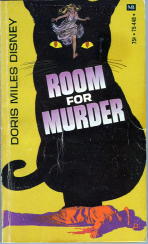
Running the rooming house are two spinster sisters named Aggie and Kate, Irish through and through, and who argue and quarrel with each other nearly all day long, or at least whenever they’re in the same room together. Nonetheless, having spent their lives together so far, the reader can tell that they could never live apart. Their niece Teresa has lived with the two women for most of her life and is now of marriageable age, but to her aunts’ ever growing frustration, she shows no signs of finding a suitable man to marry, or wishing to.
There are other relatives, and of course there are the boarders, some of them long-term and some relatively new, and all have their own particular eccentricities, shall we say. It is one of the more recent roomers who is found dead after coming home after what appears to have been a long night of drinking. Suicide is the verdict of the local (Somerset, Connecticut) police department. Aggie, who reads true crime magazines, is not so sure, and surprisingly enough, ventures out on a long trip from home alone to prove it.
I have not mentioned Dennis Callahan yet. He is one of the policeman called to the scene of the roomer’s death, and while he is there, he and Teresa immediately catch each other’s eye, much to the two sister’s displeasure. A mere policeman, he is, even though he has a solid Irish name – and there’s a story behind that as well.
The case itself is complicated, and unfortunately, to my own personal regret, most of the detection takes place offstage. On the other hand, Mrs. Disney doesn’t pull any punches. As cozy and light as the banter in the rooming house is, there is a villain that is as nasty as any you will find in many other much tougher venues. It’s a clever mix that I found both unusual and, well, delightful.
« Previous Page — Next Page »
